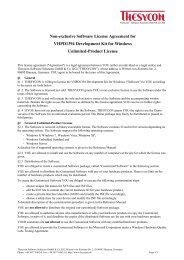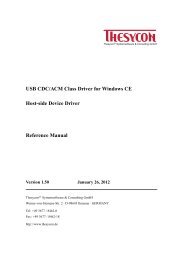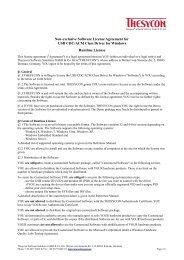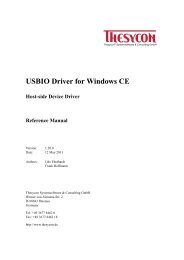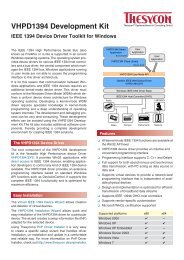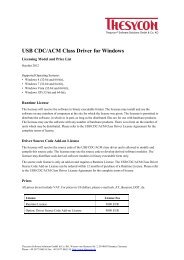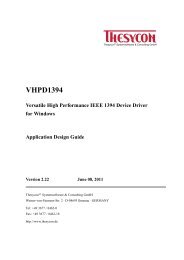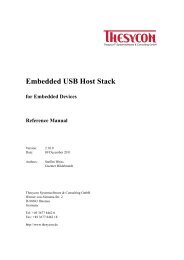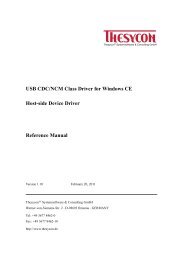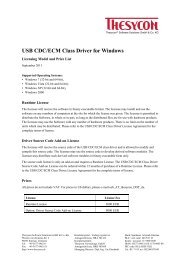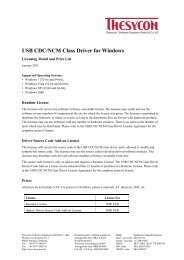PnP Driver Installer Reference Manual - Thesycon Systemsoftware ...
PnP Driver Installer Reference Manual - Thesycon Systemsoftware ...
PnP Driver Installer Reference Manual - Thesycon Systemsoftware ...
Create successful ePaper yourself
Turn your PDF publications into a flip-book with our unique Google optimized e-Paper software.
2 Operation<br />
2.2 <strong>Driver</strong> Uninstallation<br />
During every installation the uninstallation support is installed as the very first step. So if the<br />
installation fails for any reason (see section 2.4.1) the uninstallation can be performed to cleanup<br />
the system. The uninstallation is supported in the following ways:<br />
1. If an installation is performed and the setup detects an existing installation on the target<br />
system that differs from the current one the uninstaller of the existing installation is executed<br />
before the new installation starts (see section 2.1.1). That means it is not required to<br />
explicitly cleanup the system before an installation. This is implicitly done by the installer.<br />
2. If not specified otherwise the installer creates an entry in the programs control panel of the<br />
system, which is the ’Programs and Features’ control panel under Windows Vista and later<br />
and the ’Add or Remove Programs’ control panel before Windows Vista. The user may run<br />
the driver uninstallation by means of this control panel. In this case the uninstaller shows a<br />
graphical user interface. You can prevent the installer from creating an entry in the control<br />
panel by means of the appropriate command line parameter (see section 2.4.1). This may<br />
be useful if you provide an enclosing setup and you don’t want to allow the user to uninstall<br />
the driver package separately.<br />
3. The setup allows to perform an explicit silent uninstallation. Especially enclosing setups like<br />
application setups are addressed by this feature. Usually the uninstallation of the enclosing<br />
setup should also involve the uninstallation of the driver package. The driver setup provides<br />
the appropriate command line parameters (see section 2.4.2). Note that it is not required to<br />
use the same version of the setup executable that installed the existing driver package, but it<br />
has to be a setup executable of the same product which is defined by the setup.ini. The called<br />
setup executable may be located anywhere on the system but the corresponding setup.ini file<br />
has to be located in the same folder. The caller of the uninstallation is responsible for the<br />
deletion of the setup executable file, if required, because the application doesn’t delete itself<br />
when uninstallation is finished.<br />
Note: You should always wait for the result of the uninstallation! The uninstallation may be<br />
aborted for reasons that requires some user interaction (see section 2.4.2). Furthermore, any<br />
following installation will be aborted as long as the uninstallation is running. Even if your<br />
enclosing setup application does not intend to run an installation immediately after, the user<br />
may do so.<br />
2.3 Demo Version<br />
The demo version of the <strong>PnP</strong> <strong>Driver</strong> <strong>Installer</strong> is free and has no limitations except that it requires to<br />
run the Demo Mode Control Panel DemoModeCpl.exe concurrently. The panel must be started<br />
before the setup can be used. It requests the user to enter a random number and to enable the<br />
Demo mode by clicking the button ’Enable’. The Demo Mode Control Panel is always displayed<br />
on top of the desktop. It has to run until the (un-)installation is finished.<br />
2.4 Silent mode<br />
The <strong>PnP</strong> <strong>Driver</strong> <strong>Installer</strong> supports a silent mode that can be enabled with command line options.<br />
This mode is designed to integrate the <strong>PnP</strong> <strong>Driver</strong> <strong>Installer</strong> into a surrounding setup program.<br />
8 <strong>PnP</strong> <strong>Driver</strong> <strong>Installer</strong> <strong>Reference</strong> <strong>Manual</strong>



